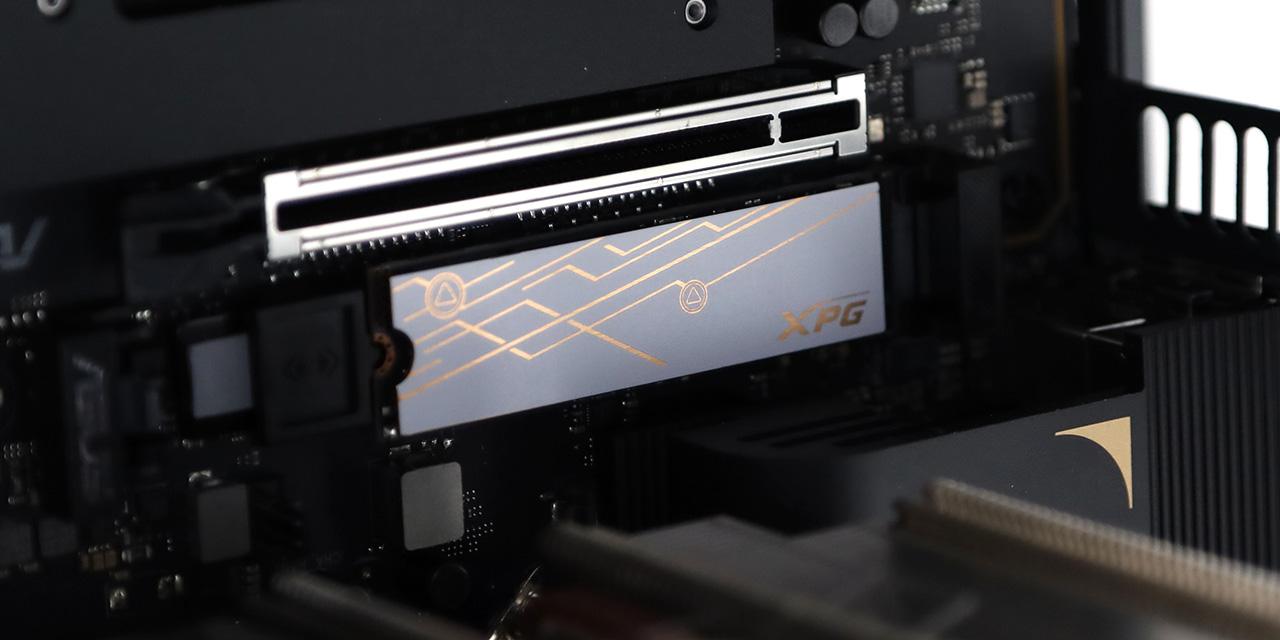Page 3 - A Closer Look, Board Layout
The Gigabyte EP45-DQ6, like the X48-DQ6, arrives in the trademark Gigabyte blue printed circuit board. Combined with copper heatpipes, this color combination is easily identifiable with the company's unique color scheme -- similar to how DFI and Asus all have their own combination to distinguish physically.
As you can see the design of the heatpipes above, it's a little more than just an L-shaped heatpipe. A C-shaped design can be seen at the top; where heat dissipation is implemented over components in three of four sides of the CPU socket in the middle. The bottom end section of the heatpipe system begins with a block that connects to the ICH10R copper block, which leads on to the main build via a single heatpipe. Two separate heatpipes lead away from the central P45 cooler to one dual section heatsink strip for heat dissipation -- this is taken advantage of when airflow is brought over the back by the rear exhaust fan in the case as well as the CPU cooler. Additionally, extra copper heatsinks are placed over the Gigabyte SATA2 chip as well as the Silicon Image Steelvine Sil5723 chips. During our tests, the heatpipe system worked well and adequately cooled our P45 chipset even under overclocking scenarios despite the fact that it's not in the correct upright orientation -- of which one is flat and parallel to the ground, and the other upside down inside our Tagan A+ Black Pearl WCR chassis.
As it has gained immense popularity for the last couple years, the Gigabyte EP45-DQ6, like many Gigabyte performance motherboards, features 100% Japanese manufactured SMD solid capacitors on the motherboard.
Also, a little short note -- the ATX 4-pin/EPS 8-pin power connector is located at the top left corner of the motherboard. Instead of the clips facing up, it faces towards the left of the motherboard -- the back I/O connectors -- which I felt it was a relatively careless design because once you have the connector clipped in, you're going to need good luck in order to get it out in a cramped case. That's the same issue we've seen with the X48-DQ6, but the one on the EP45-DQ6 is not as hard to disconnect as before.
A shot at the back of the motherboard. A relatively clean design, nothing in particular here. There's none of those large "Crazy Cool" copper plates at the back to interfere with anything. Regarding the use of capacitors, the use of surface mounts are evident, as shown in the image above. Pins still stick out for other components, for example, the RAM socket pins and PCI slots -- since SMT is not capable of withstanding higher mechanical stress required for this purpose.
The heatpipes are routed around the CPU socket; with the copper heatpipe block over the location of the Intel P45 chip. The block is not as large as the one on the Gigabyte X48T-DQ6, but works just fine as the P45 chipset generates less heat. Generally speaking, the clearing is OK and should accommodate most CPU coolers -- the capacitors and other components will not interfere with aftermarket cooling devices.
As you can see in the photo above, the CPU features a 12-phase power design -- which is, generally, pretty good for lower voltage ripples and steady power; which contributes to somewhat better overclocking results. Power usage and CPU life may also be improved on a negligible scale.
Right behind the heatpipe curve in the photo above is the CMOS battery, quite inconveniently placed. On the positive side, the EP45-DQ6 has a clear CMOS button at the bottom, so it's not a huge deal.
Gigabyte loves to promote their "Dynamic Energy Saver" on their motherboards, as seen in the large DES badge on various packaging material of this motherboard. Declared by its "E" prefix in the model name (EP45-DQ6), the Dynamic Energy Saver uses an ASIC chip as part of the system to monitor CPU load and adjust the dynamically allocated multiphase power design used in order to optimize power efficiency. This motherboard supports Intel's VRD 11.1 power specification for optimized Penryn energy utilization. By improving load efficiency of the CPU voltage regulator with this new power specification, that's where Gigabyte got the "Advanced" name from -- as compared to the previous Dynamic Energy Saver. It can drop to as low as 1-phase power regulation in deeper sleep mode.
The DDR2 RAM slots are color coded in yellow and pink in correspondence to channels A and B, respectively. Precise and accurate RAM voltage adjustments are enabled by the multiphase power regulators below the RAM slots. To the top right of the RAM slots are the power phase LEDs.
Also nicely implemented is the 24-pin ATX power connector located above the floppy connector for cabling convenience. I've always been a big fan of that; and as Gigabyte used this design on their X48-DQ6, the same goes with the EP45-DQ6.

While Intel's ICH10R Southbridge supplies up to 6 SATA2 ports and has dropped PATA support since ICH7 series, Gigabyte's SATA2 chip adds PATA support back, along with several extra SATA2 ports. Four of the SATA2 ports (Purple) pass through the Silicon Image Steelvine Sil5723 chips to the Gigabyte SATA2 chip for plug and play RAID. The Intel chipset provided SATA2 ports are colored yellow for the connectors.
The case I/O connectors are located in standard location as a built-in block. The pin bases are color colored for the user to distinguish which set of pins are together. Right above that is a horizontally placed PATA connector; which is not quite optimal in my opinion -- as I've complained about similar implementation on the Asus P5K-Deluxe.

The expansion slots, in order from the top, are: PCIe x1, PCIe x16, PCIe x1, PCIe x1, PCIe x16, PCI, and another PCI slot. This is pretty much the standard configuration; besides the usual complaint of the RAM slots a bit low and close to the first PCIe connector it's all fine. Many of the latest boards have this problem anyway.
Near the bottom left corner is the ITE8720 chip providing support for a floppy drive, COM port, and PS/2 keyboard/mouse connectors. An array of components are placed along the bottom of the board as well; where an LED backlit power, clear CMOS, and reset buttons are placed for users using the motherboard without a case (Such as benchmarking or testing) -- very convenient as I've seen it on many enthusiast motherboards. It would be nice if there's a built in HDD LED as well.
Speaking of which, when I installed the motherboard in my Tagan A+ Black Pearl WCR case, I noticed that the HDD LED doesn't flash for some reason -- it just stays lit, even with no hard drive activity. The only time it flashes normally is before Windows is loaded. The latest BIOS at press time is used.
Next to the reset button are three Texas Instruments TSB43AB23 powered IEEE 1394a internal connectors, as well as two sets of USB internal connectors for up to four USB ports/devices.
When I first saw the back of the Gigabyte EP45-DQ6, I was like, "...". FOUR GIGABIT ETHERNET PORTS? I thought two was more than enough for typical home network designs -- even if someone was to design a public and private network at home. Point being, you could do a load of stuff with something like this, although most users won't utilize all four Gigabit Ethernet ports. It's... definitely nice to have, I guess, haha.
That said, there's no lack of back I/O connectors besides the obvious lack of eSATA -- where four is provided by two expansion slot shields, along with an external-internal Molex connector, as mentioned earlier. PS/2 connectors for keyboard and mouse are there, along with eight USB 2.0 ports and an array of audio connectors. On the digital side, there's the coaxial and optical; for the analog there's the six that's pretty standard on most motherboards (4 outputs and 2 inputs).
After a fresh install of Windows XP Professional SP3 for our tests, the Gigabyte auto-install driver CD didn't work so well -- on two different configurations and fresh Windows installations, it stops responding on the audio driver installation step -- which requires an End Task via Task Manager (Without complaints though) and firing up the installation manually. Also, with the original BIOS revision that this board shipped with, our system kept crashing every few minutes. At one point, after installing NVIDIA drivers, our computer won't even boot. All stability issues seems to have been fixed with the F10a BIOS though.
Page Index
1. Introduction, Features, and Specifications
2. Bundle, Chipset, BIOS
3. A Closer Look, Board Layout
4. Test System; Benchmark: 3DMark06
5. Benchmark: PCMark05
6. Benchmark: Cinebench R10, SuperPI 1M
7. Benchmark: EVEREST CPU
8. Benchmark: EVEREST FPU
9. Benchmark: EVEREST Memory
10. Benchmark: EVEREST Memory Latency, HDTach 3.0.1.0
11. Onboard Sound (RMAA 6.06) Analyzation
12. Overclocking and Conclusion





